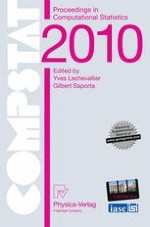2010 | OriginalPaper | Buchkapitel
Multiple Nested Reductions of Single Data Modes as a Tool to Deal with Large Data Sets
verfasst von : Iven Van Mechelen, Katrijn Van Deun
Erschienen in: Proceedings of COMPSTAT'2010
Verlag: Physica-Verlag HD
Aktivieren Sie unsere intelligente Suche, um passende Fachinhalte oder Patente zu finden.
Wählen Sie Textabschnitte aus um mit Künstlicher Intelligenz passenden Patente zu finden. powered by
Markieren Sie Textabschnitte, um KI-gestützt weitere passende Inhalte zu finden. powered by
The increased accessibility and concerted use of novel measurement technologies give rise to a data tsunami with matrices that comprise both a high number of variables and a high number of objects. As an example, one may think of transcriptomics data pertaining to the expression of a large number of genes in a large number of samples or tissues (as included in various compendia). The analysis of such data typically implies ill-conditioned optimization problems, as well as major challenges on both a computational and an interpretational level.
In the present paper, we develop a generic method to deal with these problems. This method was originally briefly proposed by Van Mechelen and Schepers (2007). It implies that single data modes (i.e., the set of objects or the set of variables under study) are subjected to multiple (discrete and/or dimensional) nested reductions.
We first formally introduce the generic multiple nested reductions method. Next, we show how a few recently proposed modeling approaches fit within the framework of this method. Subsequently, we briefly introduce a novel instantiation of the generic method, which simultaneously includes a two-mode partitioning of the objects and variables under study (Van Mechelen et al. (2004)) and a low-dimensional, principal component-type dimensional reduction of the two-mode cluster centroids. We illustrate this novel instantiation with an application on transcriptomics data for normal and tumourous colon tissues.
In the discussion, we highlight multiple nested mode reductions as a key feature of the novel method. Furthermore, we contrast the novel method with other approaches that imply different reductions for different modes, and approaches that imply a hybrid dimensional/discrete reduction of a single mode. Finally, we show in which way the multiple reductions method allows a researcher to deal with the challenges implied by the analyis of large data sets as outlined above.
